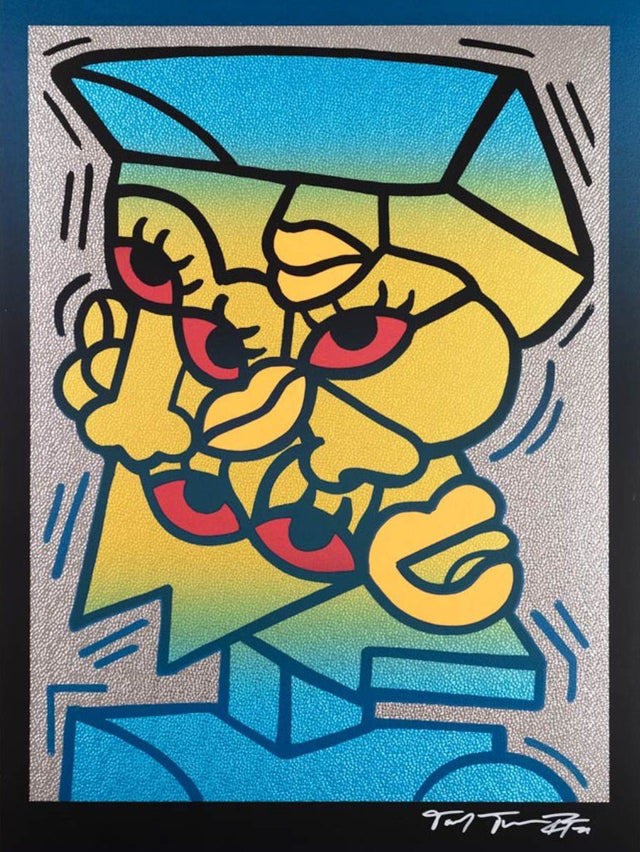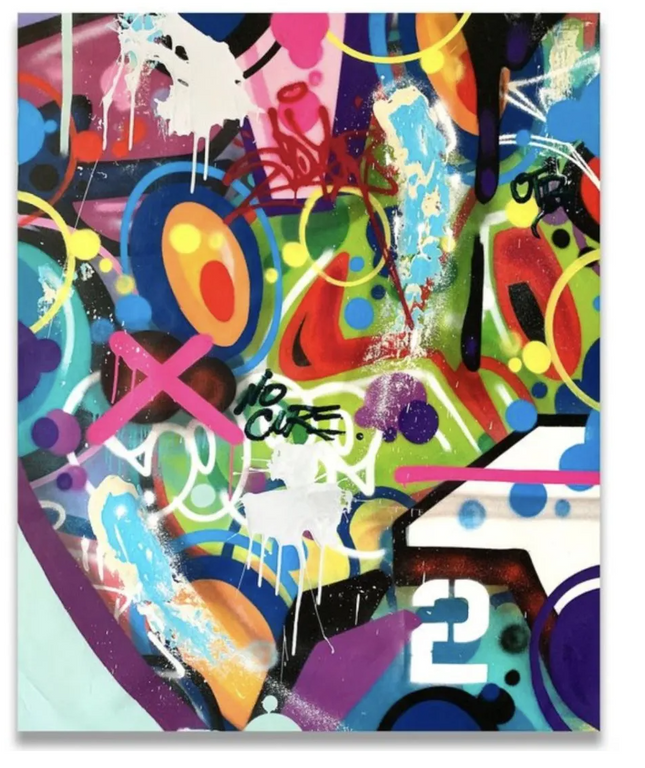
Abstract Abstraction

Cope2- Fernando Carlo No Cure Original Acrylic Spray Paint Painting by Cope2- Fernando Carlo
No Cure Original Acrylic Spray Paint Painting by Cope2- Fernando Carlo One of a Kind Artwork on Canvas by Street Art Pop Artist. 2020 Signed Mixed Media Spray Paint & Acrylic Painting Original Artwork Size 43x53 on Unstretched Canvas Explosion of Color: Fernando Carlo's "No Cure" Fernando Carlo, known in the street pop art and graffiti art world as Cope2, is a Bronx-born artist whose work vibrates with the pulse of urban life. His piece titled "No Cure Original Acrylic Spray Paint Painting" is a spectacular canvas that showcases the raw energy and colorful chaos that defines street art. Created in 2020, this one-of-a-kind artwork is an amalgam of acrylic and spray paint, reflecting Cope2's dexterity with mixed media and his deep roots in graffiti culture. Spanning an impressive 43x53 inches on unstretched canvas, "No Cure" stands as a testament to Cope2's enduring influence in the realm of contemporary street art. In the canvas, we see a riot of colors and shapes, clashing and blending in an almost musical harmony. The artwork is signed by the artist, which not only ascertains its authenticity but also marks it as a significant piece within his extensive body of work. Cope2's signature is recognized worldwide, a symbol of credibility in the constantly evolving graffiti scene. With "No Cure," Cope2 demonstrates his versatility and his commitment to the craft, delivering a visual feast that is both a nod to the past and a step into the future of street art. The Bold Artistry of Cope2 Fernando Carlo's journey as Cope2 is a story etched onto the very streets of New York. Since the 1980s, he has been a figure synonymous with the graffiti scene, often regarded as one of the godfathers of New York City subway graffiti. His style has evolved over the decades, yet it retains the essence of the movement — bold, confrontational, and unapologetically public. "No Cure" captures this evolution, its canvas a dynamic collision of traditional graffiti elements with experimental pop art aesthetics. The title "No Cure" itself evokes a sense of raw, uncontained expression. It suggests an ailment for which there is no remedy, perhaps a reference to the addictive nature of artistic creation, especially within the context of street art where the act of painting can be as compelling as the art itself. This painting does not seek to cure but to capture and convey the complex layers of city life, the artist's inner narrative, and the vibrant cultural dialogue of the streets. The unapologetic presence of text, abstract motifs, and splattered paint illustrates Cope2's fearless approach to art and life. Contextualizing "No Cure" in Street Pop Art "No Cure" is not just an artwork but a visual representation of the culture from which it emanates. To understand this piece is to delve into the history of street art and its transition into the gallery space. Street pop art, with its roots in the countercultural movements of the 20th century, seeks to bring the vitality of street culture into the often sterile world of fine art. Cope2 does this masterfully, drawing on his experiences as a Bronx native to infuse his work with an authenticity that cannot be manufactured. The year 2020, when "No Cure" was created, marked an era where street art had firmly established itself as a genre that could command the walls of high-end art spaces while retaining its street cred. In this light, Fernando Carlo's work is a bridge, connecting the gritty sidewalks lined with aerosol to the white walls of art collectors seeking a piece of the street for themselves. "No Cure" embodies the zeitgeist of contemporary urban art, a beacon of the enduring spirit and evolving nature of street pop art and graffiti artwork. In the broader discourse of street pop art, Cope2's "No Cure" is a vibrant chapter that speaks to the diversity and complexity of graffiti art. It stands as a colorful testament to the artistic force of Fernando Carlo and the indelible mark he has left on the cultural fabric of the urban landscape. As the lines between street art and fine art continue to blur, pieces like "No Cure" remind us that at the heart of this movement is the power of raw, unedited expression — a power that indeed has no cure.
$7,000.00


